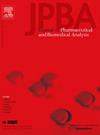Lipidomic profiling of amniotic fluid reveals aberrant fetal lung development and fetal growth disrupted by lipid disorders during gestational asthma
IF 3.1
3区 医学
Q2 CHEMISTRY, ANALYTICAL
Journal of pharmaceutical and biomedical analysis
Pub Date : 2024-09-19
DOI:10.1016/j.jpba.2024.116475
引用次数: 0
Abstract
This study aimed to investigate how maternal asthma during pregnancy disrupts fetal lung development by altering lipid metabolism in the amniotic fluid, which is crucial for fetal development. A pregnancy-induced asthma model was established in female rats using house dust mite (HDM) as a common allergen. The fetuses were divided into four groups based on whether the mother and fetus were exposed to the allergen: PBS+PBS, PBS+HDM, HDM+PBS, and HDM+HDM. Ultra-performance liquid chromatography-tandem mass spectrometry (UPLC-MS/MS) was employed to analyze changes in the lipid profile of the amniotic fluid and bronchoalveolar lavage fluid (BALF). Principal component analysis (PCA) and ChemRICH methods were used to explore the potential relationship between lipid metabolism abnormalities and impaired fetal lung development. The results indicate that maternal asthma exacerbates asthma-related inflammatory markers in fetuses, leading to pathological changes in the lungs and elevated levels of cytokines IL-5, IL-13, and IgE. Additionally, 18 differential lipids, primarily oxygenated lipids, were identified in the amniotic fluid after modeling, suggesting an enhanced oxidative stress environment for the fetus. This environment causes metabolic disturbances in various lipid groups in fetal lungs, with the HDM+HDM group showing significant abnormalities in lipids critical for lung development, including phosphatidylethanolamine (PE), phosphatidylglycerol (PG), and fatty acids (FA). In conclusion, gestational asthma can reshape the lipid profile in the amniotic fluid and BALF, significantly disrupting fetal growth and lung development. Restoring normal lipid metabolism in the amniotic fluid and fetal lungs may offer a potential therapeutic approach to managing aberrant fetal lung development in asthmatic mothers.
羊水脂质体分析显示胎儿肺发育异常以及妊娠哮喘期间脂质紊乱对胎儿生长的干扰
本研究旨在探讨妊娠期母体哮喘如何通过改变羊水中对胎儿发育至关重要的脂质代谢来干扰胎儿的肺部发育。研究以雌性大鼠为对象,以屋尘螨(HDM)为常见过敏原,建立了妊娠诱发哮喘模型。根据母体和胎儿是否接触过敏原,将胎儿分为四组:PBS+PBS、PBS+HDM、HDM+PBS 和 HDM+HDM。采用超高效液相色谱-串联质谱法(UPLC-MS/MS)分析羊水和支气管肺泡灌洗液(BALF)脂质谱的变化。采用主成分分析(PCA)和 ChemRICH 方法探讨了脂质代谢异常与胎儿肺发育受损之间的潜在关系。结果表明,母体哮喘会加剧胎儿体内与哮喘相关的炎症标记物,导致肺部病理变化以及细胞因子 IL-5、IL-13 和 IgE 水平升高。此外,建模后在羊水中发现了 18 种不同的脂质,主要是含氧脂质,这表明胎儿的氧化应激环境增强。这种环境导致胎儿肺部各种脂质组的代谢紊乱,其中 HDM+HDM 组对肺部发育至关重要的脂质(包括磷脂酰乙醇胺(PE)、磷脂酰甘油(PG)和脂肪酸(FA))出现明显异常。总之,妊娠期哮喘会重塑羊水和 BALF 中的脂质分布,严重干扰胎儿的生长和肺部发育。恢复羊水和胎儿肺部的正常脂质代谢可能是控制哮喘母亲胎儿肺部发育异常的一种潜在治疗方法。
本文章由计算机程序翻译,如有差异,请以英文原文为准。
求助全文
约1分钟内获得全文
求助全文
来源期刊
CiteScore
6.70
自引率
5.90%
发文量
588
审稿时长
37 days
期刊介绍:
This journal is an international medium directed towards the needs of academic, clinical, government and industrial analysis by publishing original research reports and critical reviews on pharmaceutical and biomedical analysis. It covers the interdisciplinary aspects of analysis in the pharmaceutical, biomedical and clinical sciences, including developments in analytical methodology, instrumentation, computation and interpretation. Submissions on novel applications focusing on drug purity and stability studies, pharmacokinetics, therapeutic monitoring, metabolic profiling; drug-related aspects of analytical biochemistry and forensic toxicology; quality assurance in the pharmaceutical industry are also welcome.
Studies from areas of well established and poorly selective methods, such as UV-VIS spectrophotometry (including derivative and multi-wavelength measurements), basic electroanalytical (potentiometric, polarographic and voltammetric) methods, fluorimetry, flow-injection analysis, etc. are accepted for publication in exceptional cases only, if a unique and substantial advantage over presently known systems is demonstrated. The same applies to the assay of simple drug formulations by any kind of methods and the determination of drugs in biological samples based merely on spiked samples. Drug purity/stability studies should contain information on the structure elucidation of the impurities/degradants.

 求助内容:
求助内容: 应助结果提醒方式:
应助结果提醒方式:


